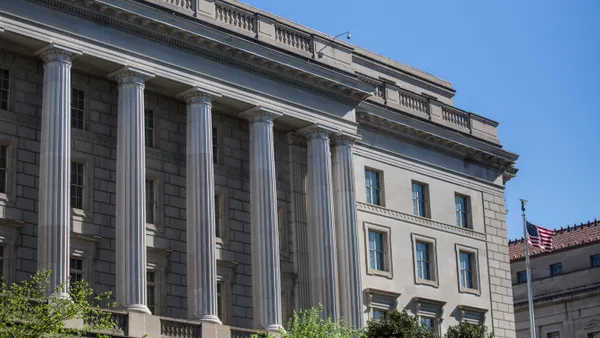Dive Brief:
- U.S. lenders and corporate borrowers need to speed up the pace of their switch from the London Interbank Offered Rate (LIBOR) to new reference rates, Federal Reserve Vice Chair Randal Quarles said, affirming that LIBOR may not be used in new financial contracts after Dec. 31.
- Large financial institutions used alternatives to LIBOR for less than 1% of corporate loans and 8% of derivatives during the second quarter, Quarles said Tuesday in a speech to the Structured Finance Association, adding that Fed supervisors will require faster adoption of alternative rates in coming weeks.
- “Market participants should act now to accelerate their transition away from LIBOR,” Quarles said. “The reign of LIBOR will end imminently, and it will not come back.”
Dive Insight:
Corporate treasurers have relied on LIBOR as a reference rate for more than three decades, and it serves as the benchmark for more than $200 trillion in mortgages, derivatives, business loans and other financial contracts worldwide.
LIBOR is derived from London banks' estimates of what they would be charged when borrowing from other banks. Regulators began considering phasing out the benchmark rate after a manipulation scandal in 2012.
The final fixings for most LIBOR rates — including one-week and two-month U.S. dollar LIBOR — will be made on Dec. 31, but other U.S. dollar tenors may continue until June 30, 2023.
“Reviewing banks’ cessation of LIBOR use after year-end will be one of the highest priorities of the Fed’s bank supervisors in the coming months,” Quarles said.
The Fed and other regulators have endorsed the Secured Overnight Financing Rate (SOFR), which is based on overnight repurchase agreements secured by U.S. Treasurys. Adoption of SOFR has been slow because it lacks some of LIBOR’s appealing traits.
LIBOR reflects credit risks and can be forecast three, six and 12 months into the future.
SOFR does not reflect credit risks and has only recently gained credibility for use in a term structure that enables corporate treasurers and financial institutions to make forward-looking rate calculations.
In July, the Alternative Reference Rates Committee (ARRC), a panel including financial institutions and the Fed, endorsed a series of term rates tied to SOFR.
ARRC acted after steady growth in the market for derivatives linked to SOFR. The number of open interest SOFR futures contracts hit a record high of 1,008,709 at the end of September, and the average daily volume of contracts traded rose 147% during the month compared with September 2020, according to CME Group, the operator of a derivatives exchange.
“The ARRC did not recommend any other rate for capital markets or derivatives, and market participants should not expect such rates to be widely available,” Quarles said.
Regulators have not endorsed a specific replacement rate for loans, Quarles noted. “If market participants do use a rate other than SOFR, they should ensure that they understand how their chosen reference rate is constructed, that they are aware of any fragilities associated with that rate, and — most importantly — that they use strong fallback provisions.”
The use of SOFR for corporate borrowing gained momentum last week when Ford announced the extension of $15.5 billion in revolving credit lines linked to the reference rate.
“This multi-billion dollar facility, arranged by one of America’s leading financial institutions for one of America’s largest corporate borrowers, marks a significant milestone in the transition away from LIBOR,” PwC said.
Ford’s borrowing “serves as a sign of confidence that simple SOFR can be used successfully in a lending transaction,” according to PwC. “For any institution aspiring to become a ‘fast follower,’ the public nature of this transaction provides insight into SOFR conventions adopted by leading institutions.”















